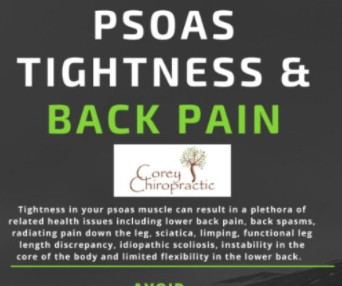
Hello again. Today we are discussing our psoas muscle and how it relates to low back pain. Let’s start by explaining what the psoas muscle is. The psoas muscle is located in the lower lumbar region of the spine, extends through the pelvis to the femur and is part of the iliopsoas muscle group. This muscle works by flexing the hip joint and lifting the upper leg towards the body. A common example of the movement created from this muscle is walking. So, you can probably understand how keeping it in optimal shape would be especially important.
Symptoms of a tight psoas can be:
- Tension and pain in the lower back, hips, buttocks, pelvis, or groin
- Lower back spasms
- Radiating pain down the leg
- Sciatica
- Lumbar disc problems
- Limping
- Functional leg length discrepancy
- Idiopathic scoliosis
- Instability in the core of the body
- Limited flexibility in the lower back
Who experiences tightness of their psoas? Office workers and athletes tend to be the most affected. This is because the tightness is caused by overuse, regular limited movement, trauma (whether physical or emotional), and sitting for long periods of time. Due to its location deep within the core of the body, the psoas muscle instinctively tightens up when we feel stress or fear. For some people, learning to let go of the tension in their psoas can be an intense emotional process. But understand that anyone can experience tightness of the psoas muscle and the pain associated with it.
Lower back pain generally involves the psoas muscle in some form or fashion. The main task of the psoas muscle is to stabilize the lower back when you lift the knee upward. Additionally, the psoas is vital for balance and you commonly exercise it whenever you walk or bend forward. Whenever the psoas muscle contracts, it pulls the spine into a condition known as hyperlordosis (when the inward curve of the spine in your lower back is exaggerated). Basically, the muscle pulls and shortens the spine into an over-arched position. Understandably, this puts a lot of stress on your spinal muscles. Muscles are not the only affected tissues, however. Psoas contraction strains vertebral joints as well. This is ultimately what causes the painful symptoms associated with the condition because the vertebral compression affects spinal nerve roots. This results in nerve pain and it is this kind of nerve pain that allows the discomfort to spread.
So, how do we rehabilitate psoas dysfunction? Massage therapy can be really good for alleviating the pain associated with tightness of the psoas. But actual rehabilitation will require additional steps. Many health professionals agree that a great psoas release technique, at least in the beginning, is constructive rest. Constructive rest is a way of lying down in a semi-supine position (on the back with the knees bent, and feet flat on the floor) that promotes good spinal alignment and release of excess tension. Medically, there’s a lot going on in constructive rest, but you’re not doing it. You just allow it to happen. Ultimately, though, certain physical exercises do the most good. These exercises are often demonstrated by a doctor in an outpatient office and at home. These exercises will include active and passive spine, hip joints, and psoas muscles manipulation and stretching. Exercises at home can include stretching and lower-impact dynamic exercises designed to stretch and strengthen the supporting musculature and allow the body to repair the injury. According to The Cleveland Clinic, it is particularly important that most of these exercises be done only with guidance of your doctor (a chiropractor is a great choice) so that you do not further injure your psoas or any other muscles.

References:
-Clevelandclinic.org (tight psoas management and treatment)
-Somaticmovementcenter.com (psoas muscle release/tight psoas muscle)
-Verywellfit.com (helping your tight psoas)
-Advancedptinpa.com (iliopsoas and back pain)
-Theadvancedspinecenter.com (role of psoas muscle in lower back pain)
